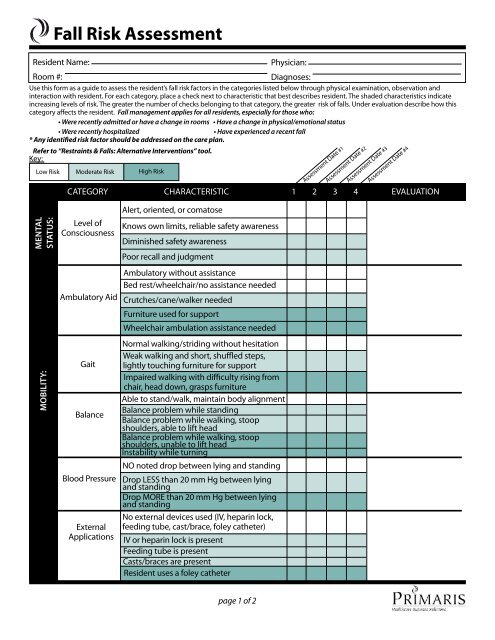Things about Dementia Fall Risk
The 9-Minute Rule for Dementia Fall Risk
Table of ContentsThe 9-Minute Rule for Dementia Fall RiskOur Dementia Fall Risk DiariesThe Main Principles Of Dementia Fall Risk All About Dementia Fall Risk
An autumn risk evaluation checks to see just how likely it is that you will certainly fall. It is mostly provided for older grownups. The assessment typically consists of: This includes a collection of concerns concerning your total health and wellness and if you have actually had previous falls or issues with equilibrium, standing, and/or strolling. These tools evaluate your toughness, equilibrium, and stride (the means you walk).STEADI consists of screening, assessing, and treatment. Interventions are referrals that may reduce your danger of falling. STEADI consists of three actions: you for your risk of succumbing to your risk factors that can be boosted to try to stop falls (as an example, equilibrium issues, impaired vision) to decrease your threat of dropping by using reliable strategies (as an example, giving education and learning and sources), you may be asked several questions consisting of: Have you fallen in the past year? Do you feel unstable when standing or strolling? Are you fretted about falling?, your service provider will certainly evaluate your toughness, balance, and stride, making use of the adhering to loss analysis devices: This test checks your gait.
If it takes you 12 seconds or more, it might indicate you are at greater threat for an autumn. This examination checks strength and balance.
Move one foot midway forward, so the instep is touching the huge toe of your various other foot. Move one foot totally in front of the various other, so the toes are touching the heel of your other foot.
The 8-Minute Rule for Dementia Fall Risk
Most falls occur as an outcome of multiple adding variables; for that reason, taking care of the risk of dropping begins with recognizing the aspects that contribute to fall danger - Dementia Fall Risk. Several of the most pertinent risk aspects include: Background of previous fallsChronic clinical conditionsAcute illnessImpaired stride and equilibrium, lower extremity weaknessCognitive impairmentChanges in visionCertain risky medications and polypharmacyEnvironmental factors can likewise raise the threat for drops, consisting of: Insufficient lightingUneven or damaged flooringWet or unsafe floorsMissing or damaged hand rails and grab barsDamaged or improperly fitted tools, such as beds, mobility devices, or walkersImproper use assistive devicesInadequate supervision of the people staying in the NF, consisting of those that display aggressive behaviorsA successful fall risk management program requires a comprehensive medical analysis, with input from all participants of the interdisciplinary group

The care strategy ought to likewise consist of interventions that are system-based, such as those that promote a secure atmosphere (proper illumination, handrails, grab bars, and so on). The efficiency of the interventions ought to be assessed periodically, and the treatment plan revised as necessary to mirror adjustments in the loss risk analysis. Applying an autumn danger management system using evidence-based ideal method can reduce the prevalence of drops in the NF, while limiting the capacity for fall-related injuries.
Some Known Incorrect Statements About Dementia Fall Risk
The AGS/BGS standard advises evaluating all adults aged 65 years and older for autumn danger yearly. This screening contains asking individuals whether they have actually dropped 2 or even more times in the past year or looked for medical interest for a loss, or, if they have not fallen, whether they really feel unsteady when strolling.
Individuals that have actually fallen as soon as without injury must have their balance and gait assessed; those with gait or balance abnormalities must receive additional evaluation. A history of 1 fall without injury and without stride or balance troubles does not necessitate more evaluation beyond continued annual fall danger testing. Dementia look at this now Fall Risk. An autumn danger assessment is called for as component of the Welcome to Medicare exam

Top Guidelines Of Dementia Fall Risk
Documenting a falls background is just one of the quality indicators for fall avoidance and monitoring. An essential component of danger evaluation is a medicine evaluation. Numerous classes of medicines boost fall danger (Table 2). copyright medications specifically are independent predictors of drops. These medications tend to be sedating, alter the sensorium, and impair equilibrium and gait.
Postural hypotension can usually be reduced by lowering the dose of blood pressurelowering drugs and/or quiting medications that have orthostatic hypotension as a negative effects. Use above-the-knee assistance pipe and resting with the head of the bed raised may also minimize postural decreases in high blood pressure. The preferred aspects of a fall-focused checkup are received Box 1.

A blog yank time more than or equal to 12 secs recommends high autumn threat. The 30-Second Chair Stand test examines lower extremity go to these guys toughness and balance. Being incapable to stand from a chair of knee height without utilizing one's arms suggests raised fall threat. The 4-Stage Balance examination analyzes fixed balance by having the patient stand in 4 positions, each gradually extra challenging.